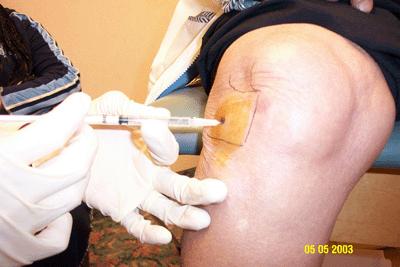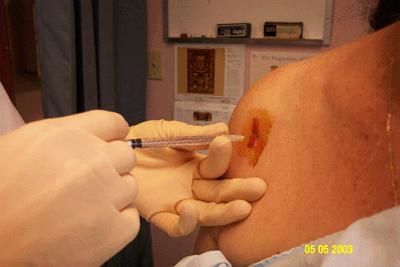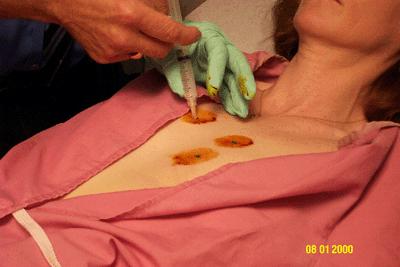Home »
Current Treatments »
Joint Injection Procedures
Joint Injection Procedures
The injection of various medications into joints or other tissues is an excellent means of treatment. Injection procedures offer several advantages over the administration of medications systemically. Joint or soft tissue injection assures that the desired medication gets into the affected joint while avoiding potential side effects of those same medications in other parts of the body. Injections are relatively cheap when compared with other medical procedures. When performed by experienced personnel like those at the Arthritis Center, rheumatologic procedures are nearly painless, about the same or less than having your blood drawn at a lab. Injections are useful for many types of arthritis, including osteoarthritis, rheumatoid arthritis, gout, or arthritis induced by injury.
 A simple knee injection.
A simple knee injection.
The most common types of medications injected into joints are steroids, cortisone-like drugs. Steroids are powerful anti-inflammatories but can have serious side effects when given systemically (by mouth, vein, or intra-muscular injection) on a regular basis. Intra-articular (in the joint) administration delivers the medication to the affected area with minimal or no effects to the rest of the body.
 Injection of the biceps tendon.
Injection of the biceps tendon.
Intra-articular injections are done with careful cleansing of the skin. The skin is then sprayed with an icy cold substance for freezing and numbing. Liberal amounts of lidocaine, a numbing agent, are used. At the Arthritis Center, we use specially ordered ultra-skinny needles to ensure minimal discomfort. We have developed our injection techniques into an art, and the vast majority of injections performed at the Arthritis Center are accompanied by less discomfort than is caused by simple venipuncture (laboratory blood drawing). Many of our patients quite literally do not even feel their injections at all.
The knee is the most commonly injected joint because it is a large, easily accessible, and is one of the most commonly affected joints in many types of arthritis. Aspiration (removal of fluid) of the knee is also a useful procedure, frequently providing valuable diagnostic information when the fluid is sent to a lab for analysis.
Another common problem that responds well to injection is tendonitis of the shoulder. Injection of cortisone can alleviate this common problem quickly and without side effects.
 Injection of costochondral joints.
Injection of costochondral joints.
The costochondral joints, which connect the ribs to the breastbone, are also amenable to injection therapy. Costochondritis, a painful but otherwise harmless inflammatory condition of these joints, is responsible for millions of dollars worth of medical tests each year because it can be mis-identified as a heart or stomach problem. A careful examination will usually show that the source of the pain is really on the chest wall, much more superficial than it would be in the more serious conditions.
If you have arthritis or other sources of joint or tendon problems in a few isolated places, listen carefully when your doctor suggests injection. Performed by experienced personnel, intra-articular injections are quick and relatively painless treatments that can help avoid serious side effects.